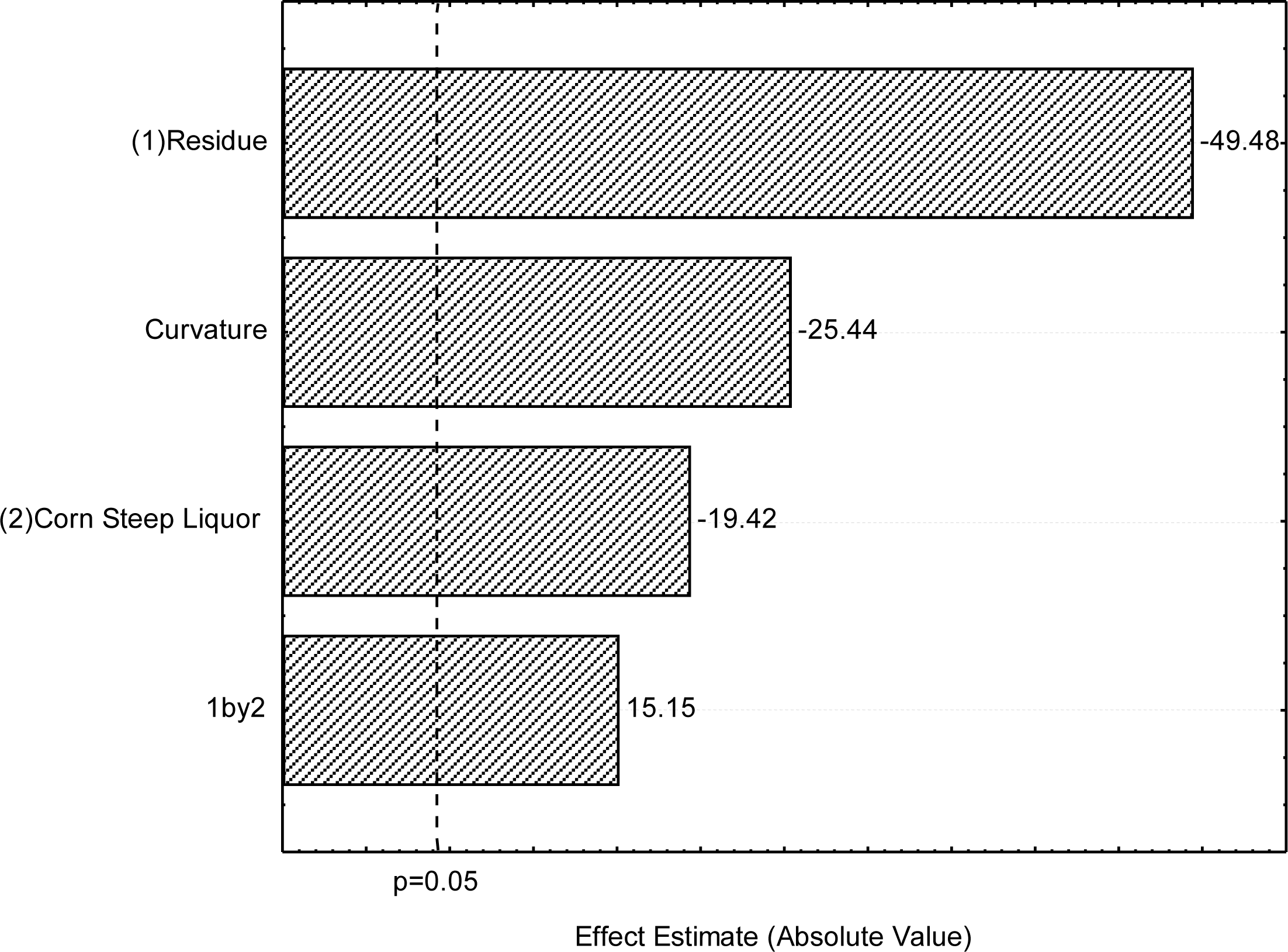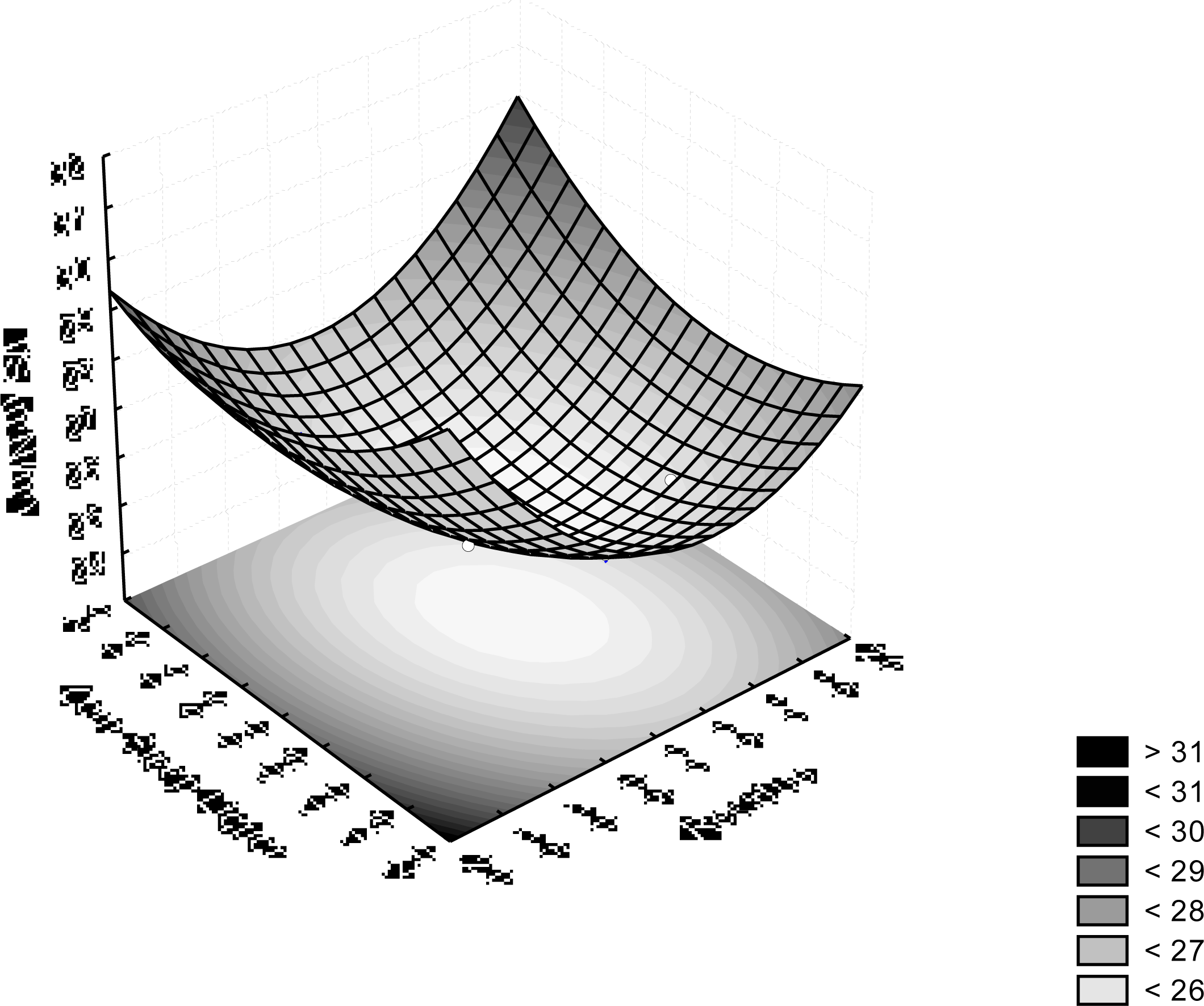Economic Optimized Medium for Tensio-Active Agent Production by Candida sphaerica UCP0995 and Application in the Removal of Hydrophobic Contaminant from Sand
Abstract
:1. Introduction
2. Results and Discussion
2.1. Screening Experiments
2.2. First Full Factorial Design
2.3. Second Full Factorial Design
2.4. Third Full Factorial Design
2.5. Optimization Experiment
2.6. Application of the Biosurfactant in the Removal of Hydrophobic Contaminant Adsorbed in Sand
3. Experimental Section
3.1. Microorganism
3.2. Agroindustrial Wastes
3.3. Biosurfactant Production
3.4. Surface Activity Assay
3.5. Optimization of the Biosurfactant Production Medium
3.6. Application of the Biosurfactant in Removing Motor Oil from Contaminated Sand
4. Conclusions
Acknowledgments
References
- Christofi, N; Ivshina, IB. Microbial surfactants and their use in field studies of soil remediation. J. Appl. Microbiol 2002, 93, 915–929. [Google Scholar]
- Van Hamme, JD; Singh, A; Ward, OW. Physiological aspects. Part 1 in a series of papers devoted to surfactants in microbiology and biotechnology. Biotechnol. Adv 2006, 24, 604–620. [Google Scholar]
- Muthusamy, K; Gopalakrishnan, S; Ravi, TK; Sivachidambaram, P. Biosurfactants: Properties, commercial production and application. Curr. Sci 2008, 94, 737–746. [Google Scholar]
- Mercade, ME; Manresa, MA. The use of agroindustrial by-products for biosurfactant production. JAOCS 1994, 71, 61–64. [Google Scholar]
- Haarland, PD. Experimental Design in Biotechnology; Elsevier Science Publishing: New York, NY, USA, 1990. [Google Scholar]
- Khuri, AI; Cornell, JA. Response Surfaces: Designs and Analyses; Dekker: New York, NY, USA, 1987. [Google Scholar]
- Rao, PV; Jayaraman, K; Lakshmana, CM. Production of lipase by Candida rugosa in solid-state fermentation. 2: Medium optimization and effect of aeration. Process Biochem 1993, 28, 391–395. [Google Scholar]
- Chen, HC. Optimizing the concentration of carbon, nitrogen and phosphorus in a citric acid fermentation with response surface method. Food Biotech 1996, 10, 13–27. [Google Scholar]
- Musial, I; Rymowicz, W; Cibis, E. Optimization of single-cell biomass production by Yarrowia lipolytica using response surface methodology and pulse method. Electr J Polish Agr Univ. 2004, 7. Available online: http://www.ejpau.media.pl/volume7/issue1/biotechnology/art-02.html (accessed on 5 January 2011).
- Albuquerque, CDC; Fileti, AMF; Campos-Takaki, GM. Optmizing the medium components in bioemulsifiers production by Candida lipolytica with response surface method. Can. J. Microbiol 2006, 52, 575–583. [Google Scholar]
- Box, GEP; Drapper, NR. Response Surfaces, Mixtures, and Ridge Analyses, 2nd ed; Wiley: New York, NY, USA, 2007. [Google Scholar]
- Rufino, RD; Sarubbo, LA; Campos-Takaki, GM. Enhancement of stability of biosurfactant produced by Candida lipolytica using industrial residue as substrate. World J. Microbiol. Biotech 2007, 23, 729–734. [Google Scholar]
- Sobrinho, HBS; Rufino, RD; Luna, JM; Salgueiro, AA; Campos-Takaki, GM; Leite, LA; Sarubbo, LFC. Utilization of two agroindustrial by-products for the production of a surfactant by Candida sphaerica UCP0995. Process Biochem 2008, 43, 912–917. [Google Scholar]
- Rodrigues, LR; Teixeira, JA; Oliveira, R. Low-cost fermentative medium for biosurfactant production by probiotic bacteria. Biochem. Eng. J 2006, 32, 135–142. [Google Scholar] [Green Version]
- Albuquerque, CDC; Campos-Takaki, GM; Fileti, AMF. On-line biomass estimation in biosurfactant production process by Candida lipolytica UCP 988. J. Ind. Microbiol. Biotech 2008, 35, 1367–5435. [Google Scholar]
- Oliveira, FJS; Vazquez, L; Campos, NP; França, FP. Production of rhamnolipids by a Pseudomonas alcaligenes strain. Process Biochem 2009, 44, 383–389. [Google Scholar]
- Cunha, CD; Rosário, M; Rosado, AS; Leite, SGF. Serratia sp. SVGG16: A promising biosurfactant producer isolated from tropical soil during growth with ethanol-blended gasoline. Process Biochem 2004, 39, 2277–2282. [Google Scholar]
- Adinarayana, K; Ellaiah, P. Response surface optimization of the critical medium components for the production of alkaline protease by a newly isolated bacillus sp. J. Pharm. Sci 2002, 5, 272–278. [Google Scholar]
- Batista, RM; Rufino, RD; Luna, JM; Souza, JEG; Sarubbo, LA. Effect of medium components on the production of biosurfactant from Candida tropicallis applied to the removal of hydrophobic contaminants in soil. Water Environ Res, 2011. (in press). [Google Scholar]
- Coimbra, CD; Rufino, RD; Luna, JM; Sarubbo, LA. Studies of the cell surface properties of Candida species and relation to the production of biosurfactants for environmental applications. Curr. Microbiol 2009, 58, 245–251. [Google Scholar]
- Joshi, S; Bharucha, C; Jha, S; Yadav, S; Nerurkar, A; Desai, AJ. Biosurfactant production using molasses and whey under thermophilic conditions. Biores. Technol 2008, 99, 195–199. [Google Scholar]
- Luna, JM; Sarubbo, LA; Campos-Takaki, GM. A new biosurfactant produced by Candida glabrata UCP1002: Characteristics of stability and application in oil recovery. Br. Arch. Biol. Tech 2009, 52, 785–793. [Google Scholar]
- Rufino, RD; Sarubbo, LA; Neto, BB; Campos-Takaki, GM. Experimental design for the production of tensio-active agent by Candida lipolytica. J. Ind. Microbiol. Biotech 2008, 35, 907–914. [Google Scholar]
- Kuyukina, MS; Ivshina, IB; Makarov, SO; Litvinenko, LV; Cunningham, CJ; Philip, JC. Effect of biosurfactants on crude oil desorption and mobilization in a soil system. Environ. Int 2005, 31, 155–161. [Google Scholar]
- Crolla, A; Kennedy, KJ. Optimization of citric acid production from Candida lipolytica Y-1095 using n-paraffin. J. Biotechnol 2007, 89, 27–40. [Google Scholar]
- Rao, JLUM; Satyanarayana, T. Statistical optimization of a high maltose-forming hyperthermostable Geobacillus thermoleovorans using response surface methodology. J. Appl. Microbiol 2003, 95, 712–718. [Google Scholar]





| First Full Factorial Design | |||
| Factor | Level | ||
| −1 | 0 | +1 | |
| Soybean oil refinery residue (%v/v) | 0 | 3 | 6 |
| Corn steep liquor (%v/v) | 0 | 3 | 6 |
| Second Full Factorial Design | |||
| Factor | Level | ||
| −1 | 0 | +1 | |
| Soybean oil refinery residue (%v/v) | 6 | 9 | 12 |
| Corn steep liquor (%v/v) | 6 | 9 | 12 |
| Third Full Factorial Design | |||
| Factor | Level | ||
| −1 | 0 | +1 | |
| Soybean oil refinery residue (%v/v) | 6 | 9 | 12 |
| Corn steep liquor (%v/v) | 9 | 12 | 15 |
| Central Composite Design | |||||
|---|---|---|---|---|---|
| Factor | Level | ||||
| −1.41 | −1 | 0 | +1 | −1.41 | |
| Soybean oil residue (%v/v) | 3.68 | 5 | 8 | 11 | 12.32 |
| Corn steep liquor (%v/v) | 4.68 | 6 | 9 | 12 | 13.32 |
| Assay | Soybean Oil Residue | Corn Steep Liquor | Surface Tension (mN/m) | ||
|---|---|---|---|---|---|
| First FFD | Second FFD | Third FFD | |||
| 1 | −1 | −1 | 68.64 | 25.50 | 25.17 |
| 2 | 1 | −1 | 27.92 | 25.46 | 24.15 |
| 3 | −1 | 1 | 46.86 | 25.09 | 25.46 |
| 4 | 1 | 1 | 25.23 | 25.29 | 26.11 |
| 5 | 0 | 0 | 30.55 | 25.25 | 25.29 |
| 6 | 0 | 0 | 29.92 | 25.23 | 25.37 |
| 7 | 0 | 0 | 29.29 | 25.14 | 25.40 |
| Assay | Soybean Oil Residue | Corn Steep Liquor | Surface Tension (mN/m) |
|---|---|---|---|
| 1 | −1 | −1 | 26.71 |
| 2 | 1 | −1 | 26.09 |
| 3 | −1 | 1 | 26.50 |
| 4 | 1 | 1 | 26.73 |
| 5 | −1.41 | 0 | 27.25 |
| 6 | 1.41 | 0 | 25.90 |
| 7 | 0 | −1.41 | 26.03 |
| 8 | 0 | 1.41 | 25.75 |
| 9 | 0 | 0 | 25.50 |
| 10 | 0 | 0 | 25.09 |
| 11 | 0 | 0 | 25.25 |
| Source of variation | Sum of squares | Degrees of freedom | Mean square | F |
|---|---|---|---|---|
| Regression | 3.90 | 5 | 0.78 | 15.51 |
| Residual | 0.61 | 5 | 0.12 | |
| Lack of fit | 0.52 | 3 | 0.17 | 4.08 |
| Pure error | 0.09 | 2 | 0.05 | |
| Total | 4.51 | 10 | 0.45 | |
| R2 = 0.87 | R2adj = 0.73 | F(0.95, 5 , 5) = 5.05 | F(0.95, 3 ,2) = 19.20 | |
© 2011 by the authors; licensee MDPI, Basel, Switzerland. This article is an open-access article distributed under the terms and conditions of the Creative Commons Attribution license (http://creativecommons.org/licenses/by/3.0/).
Share and Cite
Luna, J.M.; Rufino, R.D.; Albuquerque, C.D.C.; Sarubbo, L.A.; Campos-Takaki, G.M. Economic Optimized Medium for Tensio-Active Agent Production by Candida sphaerica UCP0995 and Application in the Removal of Hydrophobic Contaminant from Sand. Int. J. Mol. Sci. 2011, 12, 2463-2476. https://doi.org/10.3390/ijms12042463
Luna JM, Rufino RD, Albuquerque CDC, Sarubbo LA, Campos-Takaki GM. Economic Optimized Medium for Tensio-Active Agent Production by Candida sphaerica UCP0995 and Application in the Removal of Hydrophobic Contaminant from Sand. International Journal of Molecular Sciences. 2011; 12(4):2463-2476. https://doi.org/10.3390/ijms12042463
Chicago/Turabian StyleLuna, Juliana M., Raquel D. Rufino, Clarissa D.C. Albuquerque, Leonie A. Sarubbo, and Galba M. Campos-Takaki. 2011. "Economic Optimized Medium for Tensio-Active Agent Production by Candida sphaerica UCP0995 and Application in the Removal of Hydrophobic Contaminant from Sand" International Journal of Molecular Sciences 12, no. 4: 2463-2476. https://doi.org/10.3390/ijms12042463






